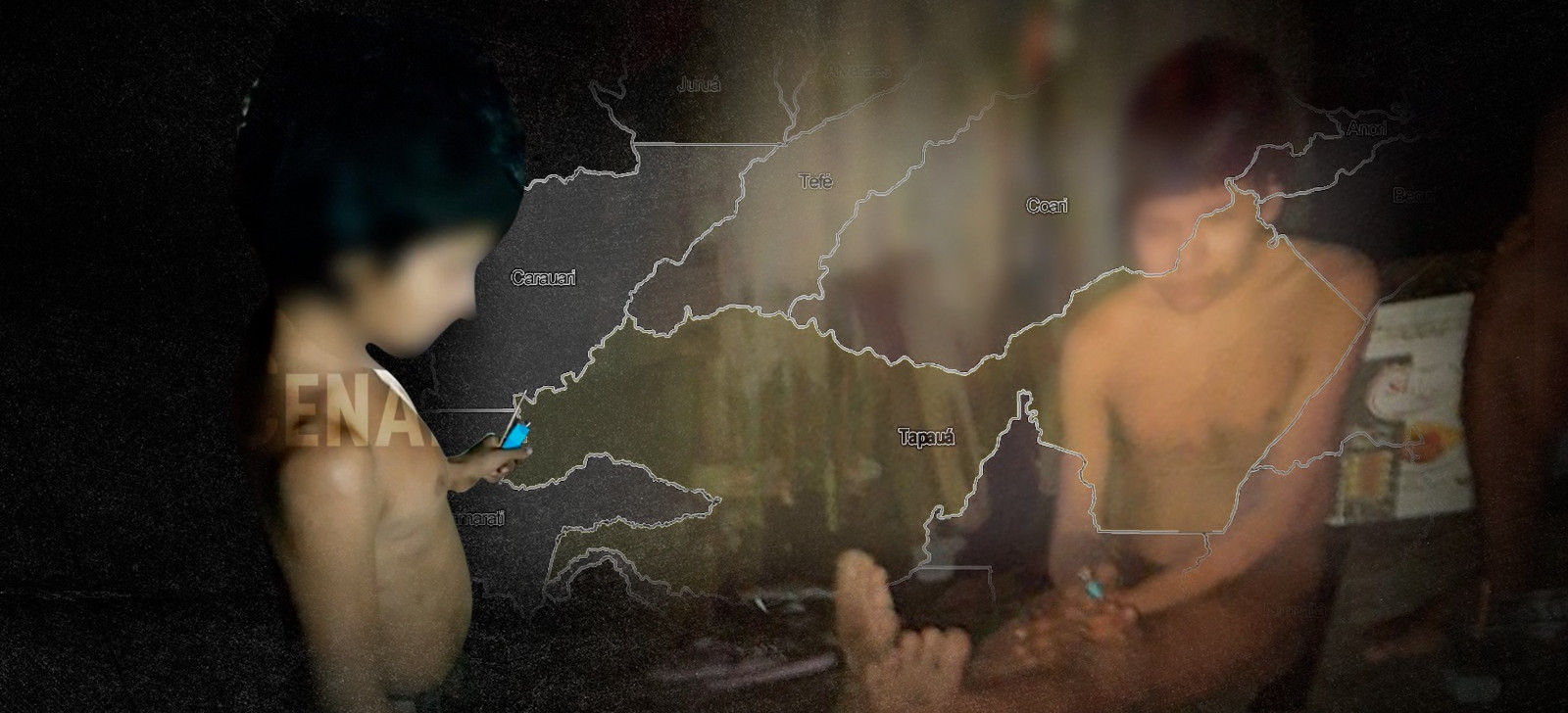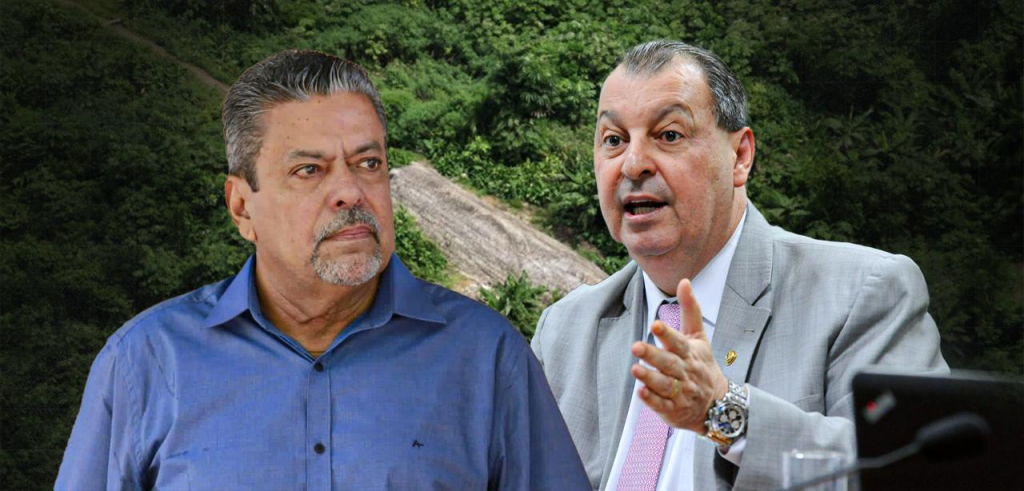Isolated Indigenous makes voluntary contact in an Amazon community
14 de February de 2025

By Bianca Diniz and Letícia Misna – From Cenarium
MANAUS (AM) – Barefoot, wearing a garment covering only the front of his genitals, impressed by fire, and speaking an unidentified language. These are the first scenes documenting the contact of an isolated Indigenous person with residents of the Bela Rosa Community, located between the municipalities of Tapauá and Lábrea (AM), along the Purus River, on the night of Wednesday, the 12th. The National Foundation for Indigenous Peoples (Funai) told CENARIUM that the contact was voluntarily initiated by the Indigenous individual and that he belongs to the Mamoriá Grande Indigenous Territory (IT), an area that had its use restricted by the Indigenous agency in December of last year.
According to Funai, the contact took place around 7:00 PM in the community, located approximately 5 kilometers from the Ethno-Environmental Protection Base (BPE) of the restricted area. Following the approach, the Madeira-Purus Ethno-Environmental Protection Front (FPE) began monitoring the situation and established a sanitary barrier to prevent contamination risks.

“The FPE team is monitoring the situation on-site, maintaining a sanitary isolation cordon around the isolated Indigenous person, awaiting the arrival of medical teams and foundation officials who are already en route to the location, where they will remain indefinitely,” the agency stated.
In one of the videos recorded by community residents, the Indigenous person appears seemingly disoriented by the environment and the people around him. He does not speak an identifiable language but interacts through gestures and speech, appearing surprised upon seeing fire created by a lighter.
A resident repeatedly ignites the lighter and then instructs the Indigenous person to try the same action. He observes the movement and attempts to imitate it. In another moment, the Indigenous person is seen sitting on a wooden table in front of a fire lit on the ground. He holds the lighter in his right hand, watching it as if trying to understand the phenomenon.
Watch below.
Funai emphasizes that it has intensified protection efforts in at-risk areas and has deployed teams for a contingency plan. “Teams are already traveling to the region and will remain there indefinitely, carrying out necessary actions to ensure everyone’s safety,” the agency stated in an official note.
In addition to the FPE, the General Coordination of Isolated and Recently Contacted Indigenous Peoples (CGIIRC) and the Indigenous Health Secretariat (Sesai) have also been called upon to monitor the case and ensure that care follows established protection protocols for isolated peoples.
Reports
Residents of the region reported that signs of isolated Indigenous people have become common. In audio obtained by the report, one resident stated that their presence is not unprecedented between Lábrea and Pauini. “We’ve seen these signs before. This is not the first time isolated Indigenous people have appeared around here,” said the unidentified resident.
Another resident mentioned that for some time, there had been discussions about the presence of isolated Indigenous people near the Bela Rosa community. “People had already commented that there were wild Indians [sic] there. Now one suddenly appeared, without clothes, and no one knows him. He doesn’t speak anything that makes sense,” he reported.
“We found three huts, very clean, with only entrance and exit holes,” described one of the residents, reinforcing signs of the presence of uncontacted Indigenous groups in the region.
Recently, when releasing images of isolated Indigenous people in the state of Rondônia, Funai highlighted the increasing frequency of these peoples approaching the boundaries of Indigenous Territory, exposing them to both direct and indirect contact with non-Indigenous individuals.
According to agents’ observations, this approach often happens due to the need to expand their occupied areas in search of survival resources, as they appear to be experiencing demographic growth.
Mamoriá Grande
In response to the case, Funai reiterated the publication of an ordinance restricting the use of the Mamoriá Grande area in Amazonas to protect the isolated Indigenous groups inhabiting the region. The presence of these groups was officially confirmed by Funai in 2021.
“The proposal for interdiction is the result of meticulous and thorough work in locating and monitoring isolated Indigenous peoples, carried out by the Madeira-Purus Ethno-Environmental Protection Front (FPW MadPur). This proposal also involved extensive dialogue with residents of the Resex and was based on the reserve’s management plan, ensuring minimal impact on the local population while safeguarding the isolated Indigenous peoples,” the statement reads.
The agency’s publication highlights that the Mamoriá Grande area faces several challenges that make its legal interdiction urgent. The main threats include “land speculation, local conflicts, in the form of threats from Resex Médio Purus residents against Indigenous people and Funai officials, and the lack of legal backing for enforcement,” as Funai previously lacked the legal basis necessary for proper inspections in the area.
In 2024, the Federal Public Prosecutor’s Office (MPF) had already recommended that Funai interdict the Mamoriá Grande area due to reports of possible sightings of isolated Indigenous peoples in the region. The decision was also directed at the Caribi Igarapé, located between the municipalities of Silves and Itapiranga, following the circulation of images online showing a possible isolated Indigenous person in the area, which would be an unprecedented record in Amazonas.
In December, following an investigation, Funai accepted the MPF’s request and, through Ordinance 1,256, ordered the interdiction of 343 kilometers of forest area in the municipalities of Tapauá and Lábrea, in the southern part of the state. The area covers a surface of 259,000 hectares. The interdiction restricts entry, movement, and residence of “individuals not affiliated with Funai” within the designated area. The decision also prohibits the exploitation of any natural resources found in the location.
The cover story of the October 2024 edition of Revista Cenarium details Funai’s position on the sighting of isolated Indigenous peoples in Amazonas. The agency highlighted the complexity of confirming such sightings, requiring long-term investigations.

Parliamentarians
Senators Omar Aziz (PSD-AM) from Amazonas and Hiran Gonçalves (Progressistas-RR) from Roraima introduced a Legislative Decree Bill (PDL) in the Senate in December last year to overturn Funai’s decision.
Aziz justified the request by arguing that Funai is “bulldozing over everyone.” “And they, with a decree, find some porcelain—we don’t even know if this porcelain is Indigenous or not—and immediately impose restrictions,” he said.
Both parliamentarians also argued that the ordinance would cause socioeconomic impacts since “traditional communities living in these areas depend directly on natural resources for their subsistence and culture. The restriction of access could also negatively affect the local economy, leading to job losses and reduced income for families reliant on these activities.”

Hiran Gonçalves said he considers Funai’s ordinance extremely harmful to the state of Roraima because 67% to 70% of its electricity comes from liquefied gas from the Azulão Field, located in Amazonas. “And Funai, with this ordinance, makes the project unfeasible. It also discourages investments that would generate much more energy for Amazonas and Brazil,” he stated.
Isolated Peoples
According to Funai, isolated Indigenous peoples are those who do not maintain consistent relations with national society or interact in a limited manner with non-Indigenous individuals and other ethnic groups. The agency states that the choice to live in isolation is usually a result of previous encounters with negative impacts, such as disease, violence, or the exploitation of their territories, threatening their survival and culture.
Funai highlights critical points for the protection of isolated peoples:
- The lack of specific and differentiated health measures for disease prevention;
- The introduction of inadequate educational systems that do not consider specific methodological models or respect different forms of alterity;
- The presence of missionaries promoting religious proselytism in Indigenous Territories;
- The imposition of market economy dynamics without prior consultation of the expectations and perspectives of Indigenous peoples, nor any monitoring that values their unique forms of socioeconomic organization.
According to Funai’s guidelines, there are records of 114 isolated Indigenous groups in the Legal Amazon, with varying levels of documented contact. The protection of these peoples aims to ensure the preservation of their traditional activities without imposing contact, respecting the autonomy and lives of each group.
In Brazil, the 1988 Constitution and Decree No. 1,775/96 guarantee the protection of isolated peoples and regulate the administrative process of demarcating Indigenous Territories. The decree mandates that lands traditionally occupied by these peoples be demarcated based on anthropological studies conducted by qualified professionals, with the participation of Indigenous communities at all stages of the process.
The decree also establishes procedures for identifying the Territories, publishing reports, and allowing interested parties, such as states and municipalities, to express their views. The demarcation is formalized by a presidential decree and subsequently ratified and registered with a notary.
“The Indigenous Territories, as referred to in Article 17, I, of Law No. 6,001, of December 19, 1973, and Article 231 of the Constitution, shall be administratively demarcated at the initiative and under the guidance of the federal agency for Indigenous assistance, in accordance with the provisions of this decree,” the decree states.
The International Labour Organization (ILO) Convention 169, ratified by Brazil, also establishes international standards for the protection of Indigenous peoples, including isolated groups, as highlighted in Article 6. “Whenever legislative or administrative measures likely to directly affect the concerned peoples are considered, such measures shall be adopted only after prior, free, and informed consultation, carried out in good faith and through appropriate procedures, with the participation of the peoples in question,” it states.
STF sets regulations
Supreme Federal Court (STF) Justice Edson Fachin partially approved, in October 2024, a plan presented by the federal government for the protection of isolated and recently contacted Indigenous peoples. At the time, the decision required the federal government and Funai to implement additional measures within set deadlines.
Among the measures, the minister emphasized the need to complete the restructuring study of Funai, particularly in areas responsible for territorial protection and the rights of isolated Indigenous peoples.
Regarding Indigenous Territories, Minister Fachin ordered Funai to provide monthly updates on the progress of the Circumstantial Identification and Delimitation Reports (RCIDs) concerning the Pirikpura and Pirititi Indigenous Territories. The states of Amazonas and Mato Grosso, along with the federal government, must also present coordinated action plans to curb deforestation in the Kawahiva do Rio Pardo Indigenous Territory and assess the possibility of expediting the physical demarcation of the territory.

